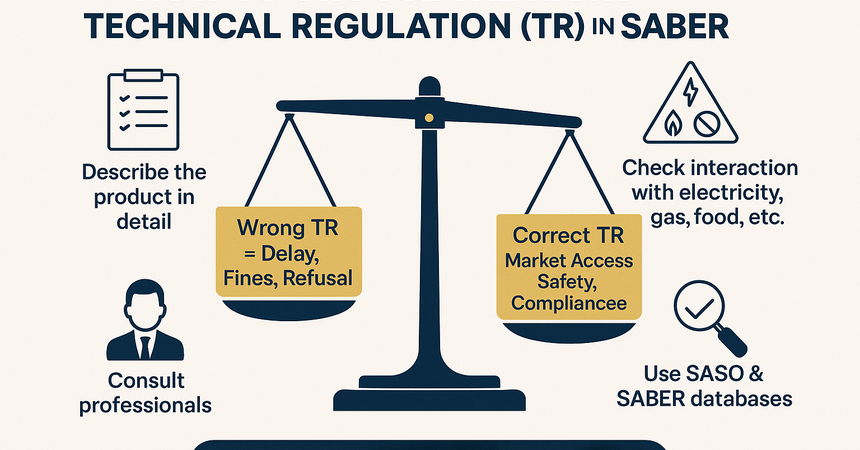Entering the Saudi Arabian market requires compliance with a range of regulations and standards set by local authorities. One of the key steps in preparing for export is identifying the correct Technical Regulation (TR), which outlines mandatory safety and quality requirements for the product. Choosing the wrong regulation can result in certification denial, fines, or a complete halt in shipments.
Let’s take a closer look at how to correctly determine the applicable Technical Regulation for product registration in the SABER system — and how to avoid critical mistakes.
What Is a Technical Regulation and Why Is It Important?
A technical regulation is a document that sets requirements for product characteristics, as well as for its design, production, and use. In Saudi Arabia, these requirements are defined by SASO (Saudi Standards, Metrology and Quality Organization) and apply to all goods imported into the country.Each regulation aims to ensure consumer safety, environmental protection, and the prevention of unsafe or substandard products entering the market.
In the SABER system, products are divided into two main categories:
- Regulated products — items with an assigned technical regulation.
- Unregulated products — items for which no specific TR has been established.
How to Determine Which Category Your Product Falls Into
The first step is to describe the product as accurately as possible. Consider not only its name and intended use but also its construction, materials, method of use, and any potential risks to health or the environment. For instance, a basic hairdryer and one with ionization or humidifying features may fall under different regulations.Then, check the following parameters:
- The product’s functional purpose.
- Interaction with electricity, water, gas, or chemicals.
- Contact with food or skin.
- Whether it has child-related or medical features.
Using Official SASO Directories and Databases
SASO provides lists of products and corresponding technical regulations. These can be found on the official SASO and SABER websites or through certification bodies’ catalogs. Each item in these lists is linked to a TR and includes references to relevant standards.However, keep in mind:
- These lists are regularly updated.
- Regulations may change in response to new risks or technologies.
- In some cases, a product may fall under multiple TRs simultaneously.
Common Mistakes in Choosing the Right Technical Regulation
Errors at this stage are frequent. For example:- Classifying household electronics as unregulated when they actually fall under electrical safety TRs.
- Applying a general regulation to cosmetics when a specific TR with stricter safety standards exists.
- Overlooking additional requirements for children’s products, such as toys with small parts.
Consulting Notified Bodies and Experts
Complex or hybrid products (e.g., smart appliances, medical devices, complete systems) require consultation with notified bodies or accredited certification centers.Benefits of working with professionals:
- Saves time and reduces the risk of certification rejection.
- Access to up-to-date TR databases.
- Quick resolution of disputes with SASO.
- Guaranteed selection of all applicable standards.
Conclusion
Choosing the correct Technical Regulation is a crucial step for successful registration in SABER and entry into the Saudi Arabian market. This process demands careful analysis of product features, the use of official directories, and — when necessary — expert guidance.WorldWideBridge offers full support at every stage: from product analysis and TR selection to documentation, lab testing, and SABER registration. We provide a tailored approach, fast turnaround, and full support to help you enter international markets with ease.
Contact WorldWideBridge — we’ll do everything quickly, professionally, and in your best business interest.
